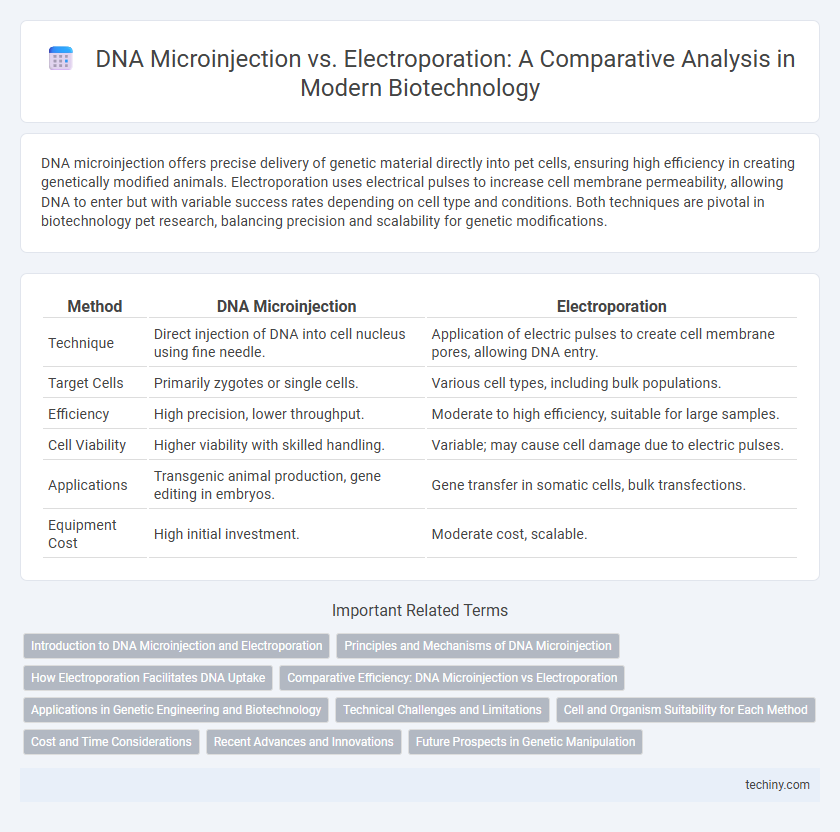DNA microinjection offers precise delivery of genetic material directly into pet cells, ensuring high efficiency in creating genetically modified animals. Electroporation uses electrical pulses to increase cell membrane permeability, allowing DNA to enter but with variable success rates depending on cell type and conditions. Both techniques are pivotal in biotechnology pet research, balancing precision and scalability for genetic modifications.
Table of Comparison
| Method | DNA Microinjection | Electroporation |
|---|---|---|
| Technique | Direct injection of DNA into cell nucleus using fine needle. | Application of electric pulses to create cell membrane pores, allowing DNA entry. |
| Target Cells | Primarily zygotes or single cells. | Various cell types, including bulk populations. |
| Efficiency | High precision, lower throughput. | Moderate to high efficiency, suitable for large samples. |
| Cell Viability | Higher viability with skilled handling. | Variable; may cause cell damage due to electric pulses. |
| Applications | Transgenic animal production, gene editing in embryos. | Gene transfer in somatic cells, bulk transfections. |
| Equipment Cost | High initial investment. | Moderate cost, scalable. |
Introduction to DNA Microinjection and Electroporation
DNA microinjection involves directly injecting genetic material into the nucleus of target cells using a fine glass micropipette, enabling precise gene transfer for transgenic organism creation. Electroporation applies controlled electric pulses to cells, temporarily disrupting the membrane to facilitate DNA uptake, widely used for transforming bacteria, mammalian cells, and plant protoplasts. Both techniques are pivotal in genetic engineering, offering distinct advantages in efficiency and cell type compatibility.
Principles and Mechanisms of DNA Microinjection
DNA microinjection involves the direct delivery of genetic material into the nucleus or cytoplasm of a target cell using a fine glass micropipette, enabling precise insertion of DNA molecules. This technique operates on the principle of physically breaching the cell membrane and nuclear envelope to introduce nucleic acids without relying on cellular uptake mechanisms, ensuring high specificity and control. It is commonly employed in generating transgenic animals and single-cell genetic modifications due to its ability to target individual cells with minimal off-target effects.
How Electroporation Facilitates DNA Uptake
Electroporation facilitates DNA uptake by applying short electrical pulses that create temporary pores in the cell membrane, allowing DNA molecules to enter the cytoplasm directly. This method enhances transfection efficiency in various cell types, including hard-to-transfect primary cells and stem cells, by overcoming membrane barriers that limit traditional microinjection. Compared to DNA microinjection, electroporation offers a higher throughput and less technical skill requirement, making it a preferred technique in genetic engineering and gene therapy research.
Comparative Efficiency: DNA Microinjection vs Electroporation
DNA microinjection offers highly precise delivery of genetic material directly into the nucleus, resulting in superior transfection efficiency for single cells or embryos. Electroporation generates transient pores in the cell membrane through electrical pulses, enabling uptake of DNA in bulk cell populations but often with lower efficiency and higher cell mortality. Comparative studies demonstrate that DNA microinjection achieves higher gene integration rates, while electroporation provides scalability for high-throughput applications despite comparatively reduced transfection precision.
Applications in Genetic Engineering and Biotechnology
DNA microinjection enables precise gene transfer by directly injecting DNA into the nucleus of target cells, widely used for creating transgenic animals and gene therapy models. Electroporation uses electrical pulses to transiently permeabilize cell membranes, facilitating efficient DNA uptake in bacterial, plant, and mammalian cells for applications like gene cloning, functional genomics, and vaccine development. Both methods are essential in genetic engineering, with microinjection preferred for single-cell manipulations and electroporation favored for high-throughput or difficult-to-transfect cell types.
Technical Challenges and Limitations
DNA microinjection faces technical challenges such as high skill requirements, low throughput, and potential damage to embryos during the injection process. Electroporation offers higher efficiency for introducing genetic material into cells but is limited by cell-type specificity and potential cytotoxicity due to electric pulse parameters. Both techniques struggle with achieving stable and uniform gene expression, posing limitations for large-scale or clinical applications.
Cell and Organism Suitability for Each Method
DNA microinjection is highly suitable for large cells and zygotes, such as those in mice and amphibians, enabling precise gene delivery into the nucleus. Electroporation is effective for a wide range of cell types, including bacterial, plant, and mammalian cells, facilitating gene transfer by creating temporary pores in the cell membrane. While microinjection excels in single-cell manipulation for transgenic animal production, electroporation is preferred for high-throughput applications and tissues with robust cell membranes.
Cost and Time Considerations
DNA microinjection involves direct delivery of genetic material into cells, offering precise control but requires specialized equipment and trained personnel, resulting in higher costs and longer preparation times. Electroporation uses electrical pulses to permeabilize cell membranes, enabling faster processing of multiple samples simultaneously with lower operational expenses and reduced labor intensity. Cost efficiency and speed make electroporation preferable for high-throughput projects, whereas microinjection remains ideal for targeted gene delivery despite its resource demands.
Recent Advances and Innovations
Recent advances in DNA microinjection technology have enhanced precision and efficiency in delivering genetic material directly into zygotes, enabling higher survival rates and reduced mosaicism in transgenic models. Electroporation innovations include refined pulse protocols and microfluidic devices that improve gene transfer efficiency while minimizing cellular damage. These cutting-edge methods streamline genome editing applications, accelerating progress in functional genomics and therapeutic development.
Future Prospects in Genetic Manipulation
DNA microinjection and electroporation each offer unique advantages for genetic manipulation, with microinjection providing precise DNA delivery into individual cells and electroporation enabling high-throughput treatment of cell populations. Emerging techniques are integrating microinjection's accuracy with electroporation's scalability to enhance gene editing efficiency in complex organisms. Future prospects include combining these methodologies with CRISPR technology to improve targeted genome modifications and therapeutic applications.
DNA Microinjection vs Electroporation Infographic

 techiny.com
techiny.com